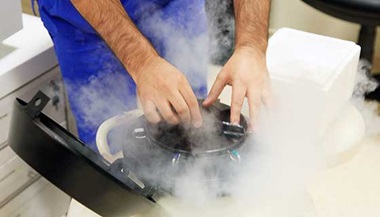Tubal Ligation
What is tubal ligation?
Tubal ligation is surgical procedure to prevent pregnancy. It has commonly been called "getting your tubes tied." It is also called a female sterilization.
- Tubal refers to the fallopian tubes. Each month, an egg is released from an ovary and travels through the fallopian tube to the uterus.
- Ligation means to tie off. This prevents the egg and male sperm from connecting to prevent pregnancy.
During this surgery, both fallopian tubes are blocked or cut. It is usually done in the hospital or in an outpatient surgical clinic. In most cases, you will be able to go home on the day of surgery. You may have this surgery done under general anesthesia (being asleep), or local or spinal anesthesia (anesthesia that leaves you awake, but unable to feel pain).
After the procedure, you will still have your periods and have sex normally. In fact, women may feel more at ease because they do not have to worry about unwanted pregnancy.
Tubal ligation is permanent birth control. Although it may be reversed by another operation, only about 50% to 80% of women are able to become pregnant after having their fallopian tubes reattached. This surgery doesn’t prevent sexually transmitted disease. You will still need to practice safe sex.
Why might I need a tubal ligation?
Reasons for choosing this birth control include:
- You are an adult woman
- Pregnancy would be a health risk for you
- You or your partner has a genetic disorder that you don't want to pass on to a child
This form of birth control may not be the best choice for you if you are unsure if you will want to become pregnant in the future. It also may not be a good choice if you may have other partners in the future. Having a new partner might make you reconsider getting pregnant.
What are the risks of a tubal ligation?
Tubal ligation is safe, but all surgeries carry some risks. Serious problems occur in less than 1 out of 1,000 women. You will need to sign a consent form that explains the risks and benefits of the surgery and you should discuss these risks and benefits with your surgeon. Some potential risks include:
- Bleeding from an incision or inside the abdomen
- Infection
- Damage to other organs inside the abdomen
- Side effects from anesthesia
- Ectopic pregnancy (an egg that becomes fertilized outside the uterus)
- Incomplete closing of a fallopian tube that results in pregnancy
Even though tubal ligation is a safe and effective form of birth control, about 1 out of 200 women may still become pregnant after the procedure. Having the surgery just after your period starts may avoid the chance that an already fertilized egg will reach your uterus after surgery.
These conditions may increase your risk for problems after surgery:
- Diabetes
- Previous abdominal surgery
- Pelvic inflammatory disease
- Lung disease
- Overweight
You may have other risks, depending on your specific health condition. Be sure to discuss any concerns with your healthcare provider before the procedure.
How do I get ready for a tubal ligation?
In the days before your surgery, tell your surgeon about any medicines you take. This includes herbal supplements and over-the-counter medicines. You may have to stop taking aspirin or other medicines that thin your blood and may increase bleeding.
Other points to go over include:
- Tell your surgeon if you or someone in your family has ever had a reaction to general or local anesthesia.
- If you smoke, you may be told to stop smoking well before surgery.
- On the day and night before surgery you may be given instructions for when to stop eating and drinking. If you are having general anesthesia, it is common to have nothing to eat or drink after midnight.
- Ask your surgeon if you should take your regular medicines with a small sip of water on the morning of the procedure.
- Wear loose comfortable clothing on the day of surgery to have an easier time getting dressed afterward.
- If you are having the surgery as an outpatient, arrange for someone to drive you home and stay with you during the early recovery period.
What happens during a tubal ligation?
Before the procedure starts you will have an intravenous line (IV) started so you can receive fluids and medicines to make you relaxed and sleepy. If you are having general anesthesia, you may get medicine through the IV to put you to sleep. A tube may be inserted in your throat so that you can inhale the anesthesia through your lungs.
If you are having local or spinal anesthesia, you will be given a numbing medicine in your abdomen or in your spinal area. You may remain awake during surgery, but you should not feel any pain. The actual surgery takes about 30 minutes.
Here is what typically happens during the procedure:
- The surgeon will make one or more small cuts (incisions) near your belly button. Sometimes the surgeon makes a small incision in your lower abdomen as well.
- Gas may be pumped into your belly to inflate it. This gives your surgeon a better view and more room to work.
- The surgeon will put a narrow tube with a light and a camera on the end into your abdomen. This tube is called a laparoscope.
- Your surgeon will use long, thin instruments put through the laparoscope or through another tiny cut to find and grab hold of the fallopian tubes.
- The tubes may be cut, tied, clamped, banded, or sealed off with an electric current.
- After surgery is done, the surgeon will close the incisions in the skin, probably using 1 to 2 stitches. He or she will cover the area with small dressings.
What happens after a tubal ligation?
After your surgery, you will be taken to the recovery room to be watched while you recover from the anesthesia. Your IV will be removed once you can drink fluids. You will probably be able to go home in a few hours.
Here is what you can probably expect at home:
- You will be able to gradually resume your normal diet.
- Some discomfort is normal. Ask your surgeon what medicines to take for pain.
- You may have shoulder pain for a few days. This is from the gas that was pumped into your belly. Lying down for a while often relieves this pain.
- Keep your incision areas dry for a few days. Follow your surgeon's instructions on bathing and dressing care. You may need to go back to have your stitches removed. Keep all your follow-up appointments.
- Gradually resume normal activities in a few days.
- Avoid heavy lifting for a few weeks. Ask your surgeon when you can return to specific activities.
- You may be able to return to sexual activity in about 1 week.
Tell your surgeon about any of the following:
- Increasing pain or pain that is not relieved by medicine
- Any drainage, bleeding, redness, or swelling
- Fever
- Vomiting or nausea
- Dizziness or fainting spells
Next steps
Before you agree to the test or the procedure make sure you know:
- The name of the test or procedure
- The reason you are having the test or procedure
- What results to expect and what they mean
- The risks and benefits of the test or procedure
- What the possible side effects or complications are
- When and where you are to have the test or procedure
- Who will do the test or procedure and what that person’s qualifications are
- What would happen if you did not have the test or procedure
- Any alternative tests or procedures to think about
- When and how will you get the results
- Who to call after the test or procedure if you have questions or problems
- How much will you have to pay for the test or procedure






